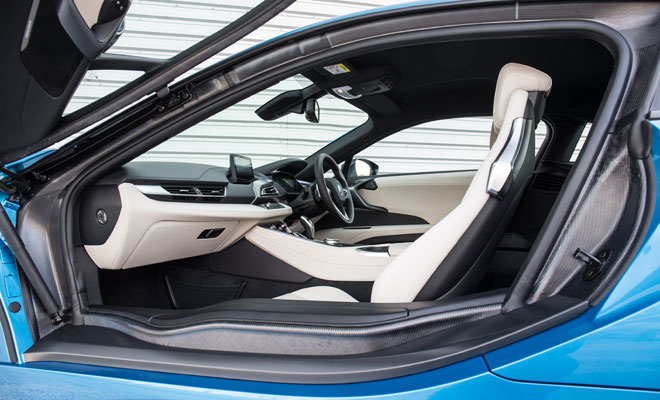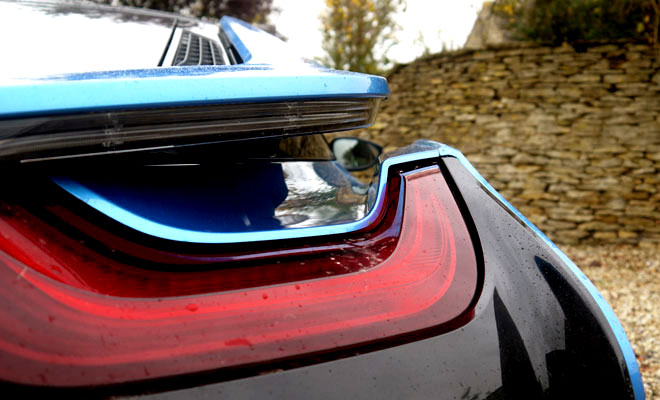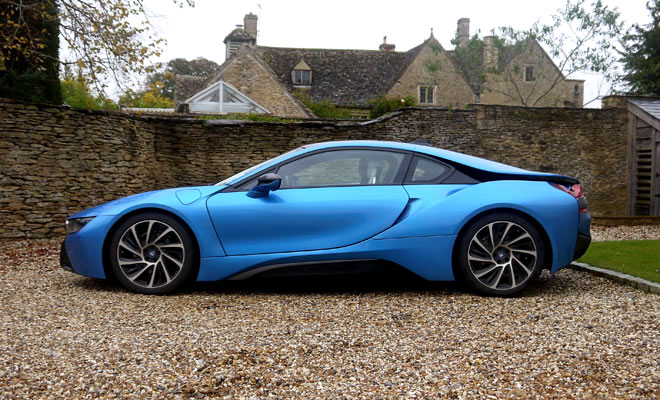by Lem Bingley
BMW’s new i8 plug-in sports car is in short supply – order one today and you’ll have to wait a whole year for delivery. As a result, test drives are being rationed. So this article is not so much a review as a taste test, just 30 minutes behind the wheel and with a BMW minder on board to boot, to make sure I don’t do anything stupid.
To be honest my co-pilot is redundant. Any lairiness is kept in check by the knowledge that the i8 costs from £99,845 before options, or quite a lot more than I can afford. Plus, if I were to break the i8 today, the wrath of BMW would be nothing to the ire of all those motoring writers further down the queue. As a result I’ve become the most careful and considerate driver in Britain for half an hour, pausing on the high-street to let a big Volvo reverse out of its parking slot, for example, just in case it might fail to spot my low-slung i8 and ram me as I slide past.
At 1.3 metres off the deck the i8’s roofline might fall below the window line of an XC90 but it’s about par for this kind of car, roughly level with the current Porsche 911. That’s about 11cm taller than the knee-high Volkswagen XL1 I drove a year ago, by the way, though the BMW still feels pretty petite.

Pop your fingers into the slot at the back of the driver’s door and it unlatches electrically, like a tailgate. The beetle-wing door will then swing up high on its gas strut and you can admire the exposed black carbon fibre visible around the aperture. No glossy, chequerboard weave here – this is the real, structural thing and it’s matte and a little uneven to the eye. But still a joy to behold, given the rarity of carbon-fibre road cars, even if the chassis is aluminium.
Twist yourself through the narrow opening – one foot over the wide sill, then your bum, then your shoulders and mind your head on the way down. The second time is easier. I’m not quite sure how anyone might reach the twin buckets of the rear “+2” seats, however.

Once settled into the snug driving seat, you can haul the door down. Also carbon fibre, skinned with plastic and fitted with thinner than standard glass, it feels uncannily light as it swings towards you. There’s no ordinary release to open the door again, instead you thumb a button to pop the lock. Another switch will unlock the glass hatch at the rear, where there’s enough room in the boot for a small overnight bag and a briefcase on top of the mid-mounted engine. For a weekend away you’ll need those teeny back seats for luggage. The bonnet is no help, being bolted shut over a full load of electric motor, radiators and other chunks of hardware.
The i8’s driving position feels suitably laid-back and low, but comfortably so and with a surprisingly good view out in most directions. The steeply raked screen does sweep unnervingly close to your forehead, with the nearest pillar seemingly aimed at your temple. And the squashed octagon of light you can see through the rear-view mirror feels a little like peering through an open letterbox, but that’s no worse than some family hatchbacks I’ve driven. I managed to reverse my i8 into a slot next to another i8 without undue fear of damaging £200,000-worth of BMWs. There’s a reversing camera to help too, though you can manage perfectly well with mirrors and eyeballs.

While you do that, try not to get distracted by the sinuous flying buttress visible in the door mirror, slinking its way over the rear haunch.
The i8 is roughly rectangular in plan but the bulk of the body is teardrop shaped for aero efficiency – BMW claims a slippery eel drag coefficient of 0.26. Air flowing around the car’s side is channelled through the slot over the rear wheel, as well as under the back axle. The arrowhead flare ahead of the rear wheel forms one wall of an air duct that runs from sill to back bumper.

On the move, the suspension provides a surprisingly supple ride – in the i8’s default Comfort mode at least – only sending thumps through to the cabin over the worst lumps and bumps. Despite this apparent softness, the i8 remains as flat through corners as you’d expect of a car with a centre of gravity only two thirds of the way up its 20-inch wheels.
The wheels are big not just for dramatic looks but for efficiency. A bigger circumference means a longer contact patch, allowing the tyre to be slimmer for a given amount of grip. The front tyres are 195/50 and the rears 215/45 – or about three-quarters the width of the rubber fitted to BMW’s M4 coupé, for comparison. Narrower tyres mean a reduction in aerodynamic drag. The tread has also been chosen to provide low rolling resistance.

Much of the interior feels familiar from other BMWs – the iDrive controller is common throughout the range, while the head-up display – fitted as standard to the i8 – seems identical to the one I used in the 4-Series Gran Coupé. The 8.8-inch central screen juts up from the dash just as it does in most other BMWs, and the twisted, lozenge-shaped gearstick is standard fit. The recycled materials, interesting shapes and futuristic feel of the i3 electric city car don’t extend to the i8, sadly.
The i8’s transmission is automatic, naturally, but you can also use the wheel-mounted paddles to scroll up and down through the six forward ratios that sit between the engine and the back axle. There’s also a two-speed transmission between the electric motor and the front axle, though that’s solely under the car’s control.
You can knock the gear lever sideways (or thumb a rocker switch) to call up the i8’s Sport setting, which will manage the gears in a more aggressive fashion, beef up the suspension and dial back the steering assistance. Sport mode will also flip the instrument panel into red-mist mode and fire up the engine, whatever speed you’re doing. It murmurs quietly into life somewhere behind your shoulder blades if you’re dawdling, ready to provide a kick in the back at a moment’s notice. The engine’s attached generator will also add charge to the battery to ensure full performance is on offer when needed. As a result, Sport mode is not the most miserly prospect – as bad as 12 litres per 100km (20mpg) can result from “sporty driving”, according to BMW.

I’m not planning to do much in thirst mode, but a section of arrow-straight road helpfully scrolls into view so I can see what full power feels like. Given a squashed throttle, the i8 takes off like a gazelle on amphetamines. The 1.5-litre, three-cylinder engine howls through the gears, doing its best impression of a 3.0-litre V6 – helped by a synthesized bellow from the stereo speakers. Any whine from the electric motor is drowned out by the din, but it is clearly pulling its weight, given that as I glance down at the HUD I’m doing 30mph more than intended. It’s a public road, so I hurriedly back off. Officially, the sprint to 62mph is dusted in 4.4 seconds.
Lifting off triggers energy recuperation, shoving energy back into the actively cooled battery that runs down the car’s spine. Thankfully, BMW has given the i8 a regeneration level that mimics conventional engine braking, rather than the aggressive clawback of the smaller i3, which feels as if you might have driven into a snowdrift the moment you ease off the throttle. The i8’s brakes feel linear right down to a standstill, without any of the kinks sometimes evident as regeneration falls away. Release the brake pedal again and the car will creep forward like an ordinary automatic, whether or not the engine happens to be running.
By default, the i8 wakes up in Comfort mode, and there’s an Eco Pro mode to help stretch the car’s economy. There’s also an eDrive switch down by the gearstick for running around silently on battery power alone. BMW quotes a range of up to 23 miles at up to 75mph on a full charge, though you won’t achieve the first benchmark if you linger at the other. Replenishing the 7.1kWh battery takes about 90 minutes from a BMW wallbox. Only 5kWh of charge is actually used, to protect the health of the lithium-ion cells.

In front-wheel-drive, electric-car guise the i8 is as quiet as a dormouse but a lot more perky. The motor provides up to 96kW (131hp) and 250Nm of torque in short bursts, which is plenty to lug the 1.6-tonne i8 around.
The petrol engine, by the way, adds another 231hp and 320Nm. Peak combined power is 362hp, while top speed is governed at 155mph.
Eco Pro mode balances the contribution of engine and motor for maximum economy, while toning down ancillaries like the air conditioning. The digital instrument panel also sprouts an efficiency gauge, while the throttle pedal becomes a little more languid. A firm prod of accelerator will still produce a startled-cat reaction from the car, however. Even set to Eco Pro, the i8 remains a sporting car.
I’m not qualified to say how the i8 compares to competitors in the £100,000 sports-car ballpark. But after a frustratingly short drive I can tell you it feels special, looks incredible, and is great fun to drive – even with a passenger from BMW watching your every move.

Fast forward: driving BMW’s i8 plug-in sports car
20 October 2014
Read more about: BMW plug-in cars test drives



